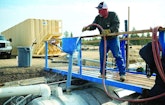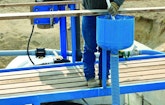
The crew at La Pine Septic Service includes, from left, Claire Coelho, Kris Coelho, Mark Coelho, Daniel Cole, Frank Stoltz, John Metzer, Jason Cox, Summer Wollenberg and Andrew Brunk. (Photos by Joe Kline)
Mark and Kris Coelho’s return to the septic service business after a decade-long hiatus began in a Staples parking lot in Provo, Utah.
That’s where they reviewed the books for La Pine Septic Service in La Pine, Oregon, after using the office supply store to receive...












